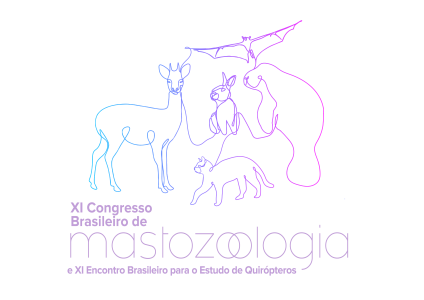Dados do Trabalho
Título:
SPACE USE AND MOVEMENT-RELATED ENERGY EXPENDITURE OF WILD BLACK LION TAMARINS BASED ON GPS AND ACCELEROMETERS
Resumo:
Forest fragmentation and habitat degradation critically affect the survival of many forest-dependent species. We aim here to quantify how patch size, forest structure and resource distribution affect space use, daily fine-scale movements, and movement costs of an arboreal endangered primate, to provide an improved evidence base for the formulation of guidelines for habitat management and, ultimately, population viability. The black lion tamarin (Leontopithecus chrysopygus), an arboreal primate endemic to the Brazilian Atlantic Forest of the state of São Paulo, is strongly endangered by habitat fragmentation and degradation. We quantified and compared the space use, movement patterns and energy expenditure of populations living in forest patches with contrasting forest structure. For this, we monitored four groups (one tamarin/group) using animal-attached GPS+accelerometer devices - two groups from a large fragment (PBC=1303ha) and two from a small one (GUA=105ha). Tamarin movements were monitored over a month with GPS locations recorded every 10 minutes during their activity period (06:00 to 18:59 BRT), used to estimate mean daily path length and 10-day home range size (95% and 50% fixed kernel UDs for total and core area, respectively). The accelerometers recorded continuously for 24 hours/day at 25-Hz frequency, providing daily length of activity period (DLA) and total VeDBA (Vectorial Dynamic Body Acceleration), which was used as proxy for daily energy expenditure (DEE). We also characterized vegetation structure and species composition by measuring height and DBH of all trees with DBH>4.5 cm, present in 22 systematically distributed 10x10 m-plots in each fragment. Both mean tree height and DBH were higher in the smaller fragment (P=0.0001, Kruskal-Wallis). We collected an average of 1152(±519) locations per group, over 10 to 22 monitoring days (72±4 locations per day). We found an up to 5-fold difference in home range size between the groups (95% and 50% Kernel: PBC01=128.2/39.8 ha, PBC02=211.8/61.4 ha, GUA01=44.2/10.4 ha, GUA02=55.1/16.4 ha), with a high home range overlap between the groups in the small fragment (GUA: 37% home range overlap, including 20% of core area), but not in the large one (PBC; overlap < 2.5%). Interestingly, mean daily path did not differ between the areas (PBC01=2753.7±434.5m, PBC02=2461.2±520.1m, GUA01=2615.6±310.8m, GUA02=2651.7±387.2m; ANOVA, P = 0.0867), whereas mean DEE was 12-29% higher in the larger fragment (P < 0.0001, ANOVA). Similarly, mean DLA was 54 minutes longer for the groups in the larger fragment (P < 0.0001, ANOVA). In the comparison among groups, DEE increased with daily path, also when correcting for DLA . Importantly, a large part of the differences in DEE was related to differences in forest structure and resource abundance, with the standard deviation in tree basal area explaining 60% of the DEE differences among groups. Basal area is a good estimator of fruit abundance and the home range of GUA01 presented the highest mean and SD values, suggesting higher resource availability and a more structurally heterogenic forest. Future studies should hence further investigate fine-scale movement patterns to clarify the effects of the vegetation structure and composition on the energy expenditure of black-lion tamarins.
Financiamento:
Fundação de Amparo à Pesquisa do Estado de São Paulo (FAPESP – processos 2020/10617-9, 2017/11962-9 e 2014/14739-0), Coordenação de Aperfeiçoamento de Pessoal de Nível Superior (CAPES – Código de Financiamento 001), Disney Conservation Fund, Durrell Wildlife Conservation Trust, Whitley Fund for Nature, Margot Marsh Biodiversity Foundation/Re:wild, Lion Tamarins of Brazil Fund, Idea Wild. Apoio: Estação Ecológica Mico-leão-preto/ICMBio, Parque Estadual do Morro do Diabo/FF-SP, IPÊ - Instituto de Pesquisas Ecológicas, Laboratório de Primatologia (LaP/UNESP).
Área
Ecologia
Autores
Gabriela Cabral Rezende, Luca Börger, Ariovaldo Pereira Cruz-Neto, Daniel Filippe, Gabriel Sabino, Laurence Culot
